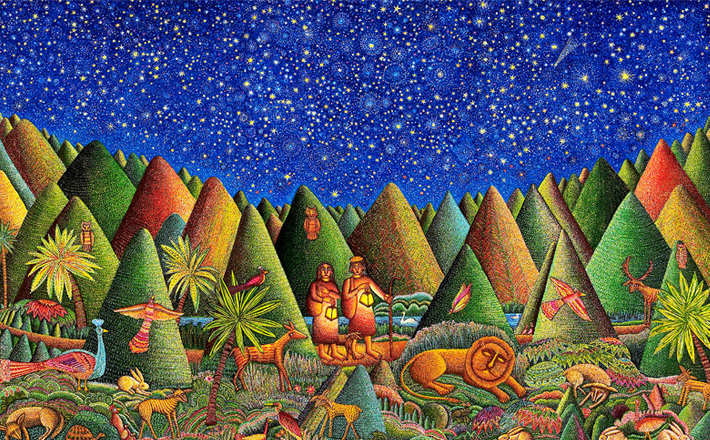Commentary on Ezekiel 37:1-14
War scars the mind as much as the body.
Horrifying images are burned into the collective memory. Civil War artist Alfred Waud, a journalist for Harper’s Weekly, sketched soldiers clearing a battlefield of the corpses of their comrades.
The smoke billowing in the background marks the pile of equine corpses that had to be burned. Assyrians artists carved battle scenes onto massive stone reliefs, where severed heads signified their power over their enemies.
The Book of Ezekiel is set against a similar backdrop. The book centers on the oracles of a former priest of Jerusalem who has been exiled to Babylon. His oracles, which are dated, span the years leading up to and immediately following Babylon’s utter destruction of Ezekiel’s former city. The language of the book bears the scars of such a collective trauma.
The book’s poems are verbal icons, using graphic verbal images to paint vibrant pictures. From the opening vision of God on a chariot throne to the final description of a city renewed, the Book of Ezekiel is visual in its orientation. The messages that the prophet relays are not just ideas but visual metaphors.
The first half of the book contains poetic oracles that describe the horrors of those years in unflinching detail. This section concludes with the depiction of the walled city as an iron pot with pieces of dead bodies floating in a gruesome stew (Ezekiel 24:1-12). Images of death permeate the book, even in the oracles promising restoration to the nation. Ezekiel 39, for example, describes future Israelites creating hills out of the bodies of the enemies they have slain.
Perhaps the most well-known passage from Ezekiel is this vision of dry bones brought to life with the breath of God. Within the Christian tradition, this passage was read as a depiction of resurrection. Such an individualized reading, however, is countered by verse 11 which explicitly states that this is an image of the restoration of the nation as a whole (37:11).
For Ezekiel’s original audience, the description of a field strewn with dry bones would immediately have called to mind images of battlefields. When an army was defeated, the victor would often leave most of the corpses unburied, stripping the bodies of any valuables while leaving the flesh for carrion birds and other predators.
In some of the Assyrian reliefs, vultures fly across the top of the frame, some with severed heads in their claws, others with dripping entrails. Ezekiel 39:17-20 depicts God summoning carrion birds to a sacrificial feast of dead bodies.
Ezekiel 37’s dry bones are all that remains after such an avian banquet. Ezekiel 37 paints the inversion of the Assyrian reliefs: instead of a battlefield of severed body parts, the battle is undone and dismembered bodies are brought back together. This inverse image counters the understandable despair of Ezekiel’s audience (37:11).
Ezekiel 37 offers a ridiculous hope. After all, to think that there is hope after the bones have been picked clean is like thinking that someone who had been buried for nearly four days could be resuscitated (John 11:17).
I find the details of the passage fascinating. First, the reintegration of the bodies happens through the prophetic speech. Could God have restored the bodies without prophetic help? I would assume so, but this passage focuses on the efficacy of the prophetic word.
Second, the passage lingers over small details in the vision: the noise of the bones coming together, the anatomical detail of bones, sinews and flesh, which gives the passage the feel of gritty corporeality. If this were a Hollywood movie, the critics would say that the special effects are incredibly realistic.
Third, if this is an anti-battle scene (or more precisely, the undoing-of-battle scene), then these details replace elements found in standard battle scenes. God replaces king as master and commander. Ezekiel replaces the generals who had led the charge. The sights and sounds of death and dismemberment are replaced by wind, bones, and a great multitude rising up from the earth.
Verse 11 states that the oracle comes in response to the people’s despair. “Our hope is lost; we are cut off completely.” These bones can do nothing to warrant a divine response. They can’t pray. They can’t repent. They won’t be offering sweet smelling sacrifices. They can only lie there, dead.
While it might be nice to focus on this restoration as an act of pure grace, verses 13-14 focus on the kind of power this God wields. God does not say, “you will know that I am your God because I loved you so much,” but rather, “once you see I can bring people back from the dead, you will know that I am truly God.”
This focus on divine power is a theme that can be traced throughout the book. In Ezekiel, God often explicitly links divine actions to the reinforcement of the divine reputation. Clearly those who experienced the exile were questioning the power of their God. Ezekiel 37 provides one more way that the book counters such doubt. It does not matter how long the nations is “dead,” God can still restore it.
If Alfred Waud had sketched an Ezekielian view of the Civil War, the soldiers who bend down to lift up the dead corpses would have been met by a living hand stretched out to comfort them. The collective scars of military disasters would have been replaced by images of a new nation, re-united in their shared identity as truly “one nation under God.”
While such visions may seem to be mere fantasies, Ezekiel 37 suggests that some fantasies might actually be closer to reality than a people’s scars might suggest. No matter how scarred a people may be, God’s ability to create a new reality is not damaged; there is no cause for despair.
PRAYER OF THE DAY
God of breath,
You promised new life to your people in exile by breathing into a valley full of dry bones. Breathe new life into us, so that we might live passionately for you. Amen.
HYMNS
The word of God is source and seed ELW 506
Awake, O sleeper, rise from death ELW 452
CHORAL
There shall a star, Felix Mendelssohn


December 8, 2013